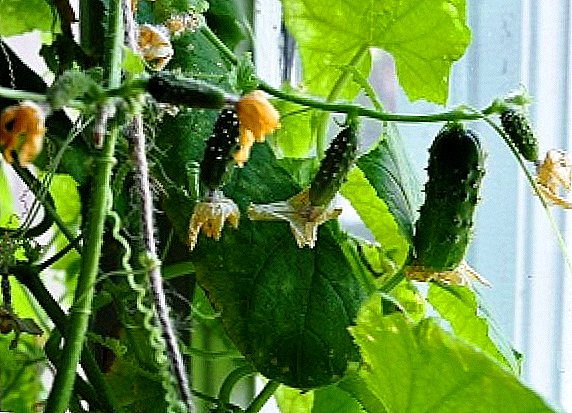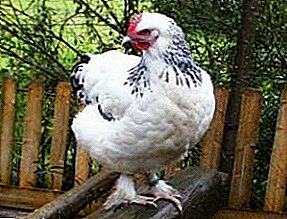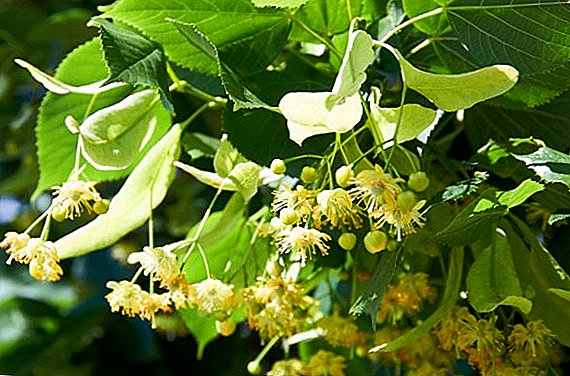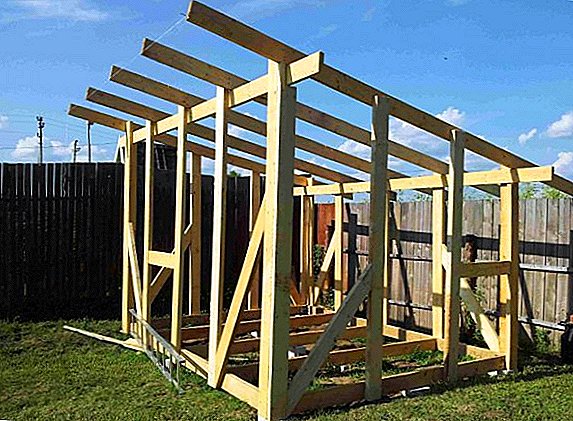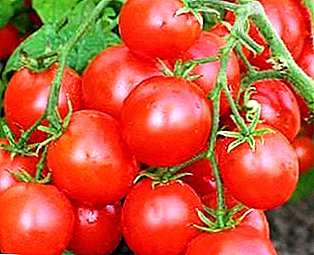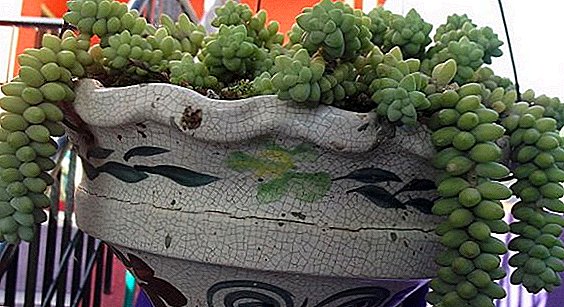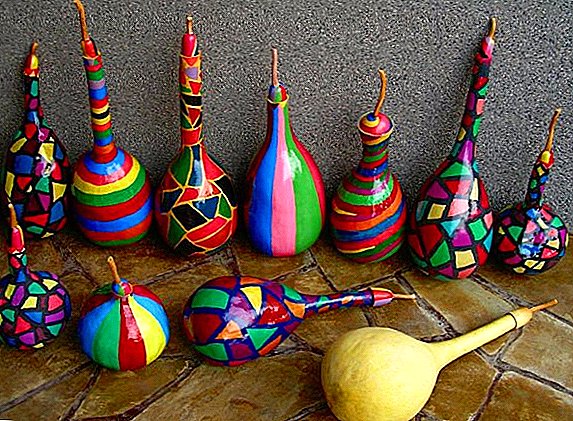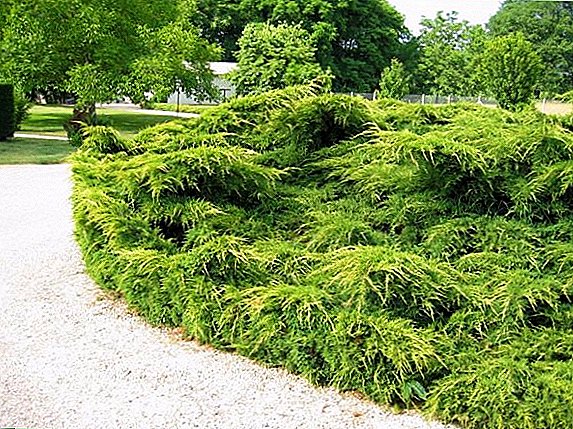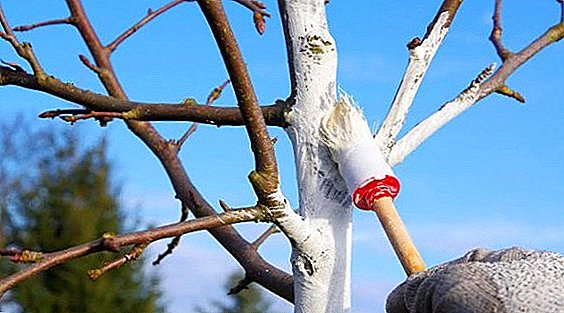 Winter is fast and steadily approaching your garden, and with it wind and icing, an invasion of rodents and pests that overwinter in the bark.
Winter is fast and steadily approaching your garden, and with it wind and icing, an invasion of rodents and pests that overwinter in the bark.
All this can damage your apple orchard.
You will find out the reason for whitening apple trees, whether to whiten only in spring, how to whiten and how to protect your garden from negative factors through proper whitewashing of trees.
What is it for?
In order to understand the reason for whitening trees, it is worthwhile to tell a little about their bark. For a tree, the bark is like leather for humans. It encounters adverse and dangerous environmental conditions first and protects internal organs. There are a lot of such unfavorable conditions for wood: sudden temperature drops, piercing winds, severe frosts and sun-rays, the effect of pests and teeth of rodents.  The bark of a tree can get sunburns or frostbite; it hurts, exfoliates and cracks. As well as damage to human skin, bark injury leads to the penetration of infection and pests into the tree, its weakening, premature withering and death.
The bark of a tree can get sunburns or frostbite; it hurts, exfoliates and cracks. As well as damage to human skin, bark injury leads to the penetration of infection and pests into the tree, its weakening, premature withering and death.
For this reason, it is necessary to protect the bark of trees.
To protect and need whitewash, it allows you to:
- protect the bark from burns - in winter and early spring, when there is no foliage serving as natural protection from the sun's rays;
- protect the apple tree from temperature fluctuations and prevent cracking of the bark;
- protect the apple tree from the action of insect pests, which lay the larvae in the bark.
Did you know? Limestone is formed on the seabed as a result of the accumulation of organic residues (mainly from shells). The most intensive limestone formation occurred in the Silurian and Jurassic periods.
It is a mistake to treat the whitewashing of apple trees as a decorative occupation. Experienced gardeners have noticed that whitewashing tree bark is an effective protective measure. 
When should be whitewashed apple trees?
Gardeners claim that the most useful to whiten trees two or three times a year:
- The main and most important whitewashing of trees is held in the autumn in the following terms: from October to November;
- renewing, repeated whitewashing of trees in spring is carried out on such dates - from the end of February to the beginning of March;
- the third whitewash is done in July.
If you want to plant an apple orchard, familiarize yourself with a variety of apple varieties: short, columnar, early and late ripening, winter-hardy.
In the spring
Consider when whitewashing is done in the spring.
They do it in February - early March, at a time when a tree trunk can warm up to a temperature of 11ºC during the day, which contributes to early sap flow. At the same time, winter and the beginning of spring have very cold nights, when the temperature can drop to -10ºC, this will result in the juice freezing, tissue rupture and the formation of frost breeders.
White paint applied to the trunks of apple trees and skeletal branches, effectively repels the rays of the sun, helps protect the bark from overheating and protects the apple tree from early awakening.
In the autumn
Let's see when to whiten an apple in the fall. It is whitewash at this time of year is considered the most important. Fruits of apple trees without this procedure not only lose their decorative effect, but also die, since sharp fluctuations in temperature in autumn and winter lead to severe damage to the bark of the apple tree.
Whitewash is necessary in october-novemberbefore the frosts start. If you successfully hold whitewash, the garden will be precisely protected from severe frosts, from the formation of frost on the branches and trunks, as well as from hungry rodents that eat the bark of apple trees.
Learn more about what care measures your garden will need in the fall: cherries, pears, peaches, grapes, currants.
Is it necessary to whiten young saplings
Young seedlings with greenish bark and incompletely formed wood are advised. do not whiten. The main reason for the refusal of whitewashing is that whitewashing can burn the unformed bark of the tree and contribute to the air insulation of the bark of the tree and wood. Because of this, metabolic processes are disturbed in young seedlings.
Experienced gardeners are advised to whiten both adults and young apple trees. If young apple trees do not whiten at all, then freezers and sunburn can damage the seedling much more than whitewashing. In order not to damage the apple sapling when whitewashing, you need to adhere such recommendations:
- Halve the concentration of the prepared lime solution.
- Instead of a solution of lime, you can use a special water-based or acrylic paint for trees.
- You can also use a silver biomask.
Did you know? In the XVII-XVIII centuries, lime was the main astringent component in the construction of houses and temples. The common people could not afford to build a house of limestone, but whitewashing the house was available.
The most popular compositions whitewash
Young apple trees can be whitened with various mixtures. The main thing is that after painting the bark was white, it could breathe and was slowly washed off. Mixtures with such criteria include the following: lime mortar, water-based paint, water-dispersion paint.
In order for the bleaching mixture to stick better to the bark of a young apple tree, can add:
- milk;
- laundry soap;
- clay;
- PVA glue;
- casein glue.
Means for whitewashing can be prepared by yourself.  Here are some simple recipes for whitewashing young apple trees, and we will answer the question: how to whiten an apple tree in the fall.
Here are some simple recipes for whitewashing young apple trees, and we will answer the question: how to whiten an apple tree in the fall.
The composition of the mixture must include components of three types:
- Means which gives a whiteness (chalk or lime).
- The means by which the solution will adhere to the cortex.
- Means that disinfects (usually used copper sulfate).
Important! Whitewashing should be exclusively white. No other color will protect young saplings from sunburn and temperature changes. The whiter the better.
In order to prepare a whitewash solution, you need to mix all the ingredients according to the option chosen. All ingredients are stirred until smooth.
The prepared solution should not be too thick, otherwise a thick layer of whitewash will peel off. A too liquid mixture will drain on the apple tree. The correct variant of the prepared solution is when the thickness of the applied mixture is 2-3 mm.  1st option:
1st option:
- 2.5 kg of lime;
- 1 bucket of water;
- 0.5 kg of copper sulphate;
- 0.2 kg casein glue.
- 2.5 kg of hydrated lime;
- 1 bucket of water;
- 0.3 kg of copper sulphate;
- 1 kg of greasy clay;
- 1 spade of cow dung.
- 2.5 kg of chalk;
- 1 bucket of water;
- 10 tablespoons flour paste.
- 2.5 kg of chalk;
- 1 bucket of water;
- 10 tablespoons of soap.
- 2 kg of chalk;
- 10 liters of water;
- 0.2 kg of clay.
Important! In order for hares and mice not to touch the bark of the trees, 20 g of carbolic acid should be added to the solution per bucket of the prepared solution.
Rules of the procedure
Consider how to whiten an apple in the fall and spring.
If whitewashing for the winter was not carried out, then in the spring, apart from whitening the apple tree, it is necessary to prepare the skeletal branches and the trunk of the trees. It is better to perform the following procedures on a damp, cloudy day.
To start an apple tree is necessary free from old dead barkTo do this, spread the fabric or oilcloth under the tree and remove with a wooden scraper pieces of bark that easily lag behind. It is necessary to process the entire stem and a third of the skeletal branches. For work, you can take the old gloves, and the exfoliated bark is better to burn.  After cleaning the bark, it must be subjected to disinfectionfor this, on a sunny day, treat the shtamb and the base of the branches with special means: a 5% solution of blue vitriol or HOM, Abigak-Peak, Oksikh.
After cleaning the bark, it must be subjected to disinfectionfor this, on a sunny day, treat the shtamb and the base of the branches with special means: a 5% solution of blue vitriol or HOM, Abigak-Peak, Oksikh.
Proper spraying is done with a spray (fine) from a very close distance, so that the liquid forms a mist, which smoothly settles on the bark, and does not flow along it. It is necessary to carry out spraying in the morning, so that by the evening the apple tree dries.
It is undesirable to disinfect annually with preparations containing copper, since the metal accumulates in the tree and its concentration becomes toxic to the apple tree. In order to protect your garden from such a phenomenon, you need to alternate spraying a soap and ash solution that is harmless to the tree, but cleans the bark no worse, and fungicide treatment.
The fungicides such as “Delan”, “Strobe”, “Poliram”, “Albit”, “Skor” are fighting with apple diseases.
 In order to heal injuries and cracks, which were formed during the processing of wood, use garden paste "RanNet", consisting of copper sulfate and humate. Since the paste is not moisture resistant, the procedure is carried out in dry weather.
In order to heal injuries and cracks, which were formed during the processing of wood, use garden paste "RanNet", consisting of copper sulfate and humate. Since the paste is not moisture resistant, the procedure is carried out in dry weather.
Also recommend the use of paste "BlagoSad" Ukrainian production, which is well responded to experienced gardeners. It is made on a natural fat base and perfectly kept on the trunk.
After all the preparatory work is done, proceed with the procedure. The optimal height is calculated by the formula: the entire stem plus a third of the skeletal branches. Mature trees are whitewashed at a height of 1.5-1.8 meters, but in principle, every experienced gardener tries to whitewash them higher.
In general, the process of whitewashing in the fall and spring is almost the same.
After reading this article and following the simple tips, you can make your garden healthy and well-groomed, and he will pay you a solid harvest.


